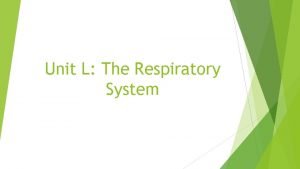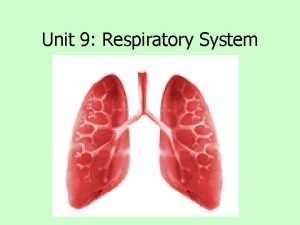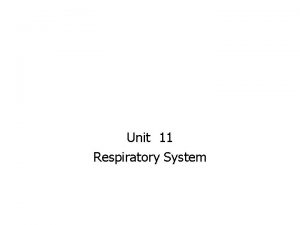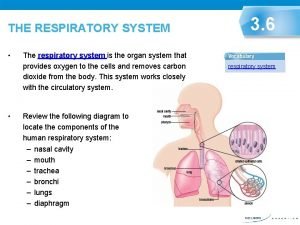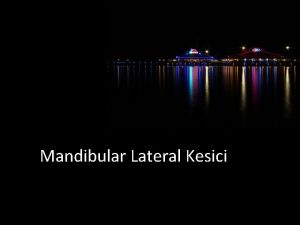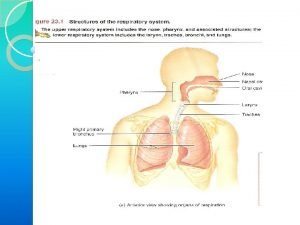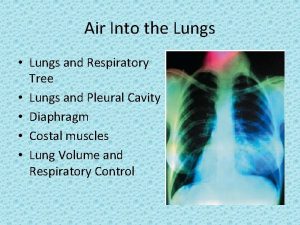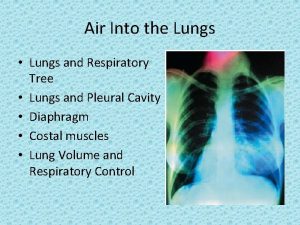Respiratory System Lungs Lungs are lateral to the










- Slides: 10

Respiratory System

Lungs • Lungs are lateral to the • • • heart Each is located in its own enclosed pleural cavity within the thoracic cavity Each lung is covered by a pleural membrane A pleural space lubricated with fluid also surrounds each lung

Pathway of Air to the Lungs • Pharynx - throat (extends to • • • larynx) Larynx - houses vocal chords leads to trachea Trachea - air passes through this tube on way to the lungs (windpipe) Bronchi - branches of trachea going to each lung Bronchioles - smaller branches of the bronchi Alveoli - air sacs surrounded by capillaries where oxygen is exchanged for CO 2 - (blood returns to heart from here)

Pathway of Air Into the Lungs Can be divided into 2 zones: • Conducting Zone • Respiratory Zone

Conducting Zone • Nose, nasal cavity, • • pharynx, larynx, trachea, bronchi Function: warm, filter and moisten inspired air Mucous traps airborne pathogens and cilia propel matter into the pharynx to be swallowed

Respiratory Zone • Bronchioles, alveoli • Function: gas exchange (CO 2 enters alveoli from blood and O 2 passes into blood from the alveoli) • Capillaries surround each alveolus for efficient gas exchange * In emphysema, the alveoli are damaged, reducing ability for gas exchange

Mechanics of Breathing • Diaphragm - muscle at the base of the lungs that regulates pressure within the pleural cavities by moving up and down

Inspiration & Expiration (see Figure 22. 13) Inspiration (breathing in) Expiration (breathing out) • Diaphragm contracts and • Diaphragm relaxes and moves down moves upwards • Intercostal muscles contract • Intercostal muscles relax and expand ribcage collapses • Volume of thoracic cavity increased as intrapulmonary decreases as (inside alveoli) pressure intrapulmonary pressure decreases increases • Air moves into lungs because • Air is forced out of lungs atmospheric pressure is because atmospheric greater than intrapulmonary pressure is less than pressure intrapulmonary pressure

Diaphragm movements

Regulation of Breathing • The medulla and pons • • contain respiratory centers that control breathing (figure 22. 24) The depth and rate of breathing are controlled by CO 2, O 2 and p. H (H+) concentrations in the blood CO 2 levels are the strongest stimulus for breathing Chemoreceptors in aorta and carotid arteries monitor blood and send signals to respiratory centers in pons and medulla
 Mikael ferm
Mikael ferm What is the conducting zone of the respiratory system
What is the conducting zone of the respiratory system Digestive system circulatory system and respiratory system
Digestive system circulatory system and respiratory system Rectangular prism total surface area formula
Rectangular prism total surface area formula Tiny air sacs at the end of the bronchioles
Tiny air sacs at the end of the bronchioles Circulatory system and respiratory system work together
Circulatory system and respiratory system work together Respiratory system bozeman
Respiratory system bozeman Unit 9 respiratory system
Unit 9 respiratory system Diagnostic test of respiratory system
Diagnostic test of respiratory system What is the respiratory system
What is the respiratory system What is larynx
What is larynx






